
What’s next for sustainability in the Nordics: governance styles-h2
data-xy-axis-lg:null; data-xy-axis-md:null; data-xy-axis-sm:80% 0%
<p><br> September 12, 2023</p>
What’s next for sustainability in the Nordics: governance
<p><b>Nordic businesses increasingly see sustainability as part of their growth strategy and, according to our recent study, they consider technology as vital to reaching that goal. To get to the next level, they will need to focus on governance structures that galvanize and incentivize all levels of the business hierarchy.</b></p>
<p>Nordic countries are <a href="https://www.weforum.org/agenda/2022/02/europe-overachieving-net-zero/" target="_blank">world-renowned sustainability leaders</a>, both when it comes to exceeding other regions’ sustainability regulations and in the aggressive targets they set for themselves.</p> <p>It’s no wonder, then, that many businesses in the region are progressive when it comes to incorporating sustainability as part of their growth strategy. Many are pushing the boundaries to become sustainability pioneers by transforming their business models and developing new products and services.</p> <p>According to our recent study of 3,000 executives globally, including 311 from the Nordics region (83 from Sweden, 81 from Denmark, 76 from Norway and 71 from Finland), Nordic businesses are also very open to the use of technology to reach their sustainability goals. In the study, conducted with Oxford Economics, more than half of respondents said they’d deployed an array of core digital technologies to improve their sustainability performance (I.e., cloud, IoT and artificial intelligence and analytics), and more than eight in 10 respondents said they were using digital tools to make their operations more energy-efficient.</p> <p>This use of technology includes both designing solutions that support the sustainability agenda (such as using AI for reporting, and blockchain for traceability) and using sustainable technology itself. For example, many businesses have strict requirements in place to buy data center services from highly green providers and buy energy through power purchase agreements or through 24x7 carbon-free energy providers.</p> <p>A key next step for the region will be focusing on sustainability governance. While C-level executives are more involved than ever in these strategies, our study reveals a need for more accountability for success at the top corporate levels. More businesses are hiring chief sustainability officers (CSO), but there’s still work to be done to create the right KPIs and ensure people are incentivized to achieve them across the organization.</p> <p>Already, Nordic businesses are making this shift as they gain more clarity on what an effective chief sustainability officer role looks like, how accountability should be allocated and how to design a governance structure that matches the sustainability strategy. The new breed of business leaders sees sustainability as intertwined with value creation, which calls for measurable KPIs connected to the sustainability agenda. Increasingly, it will be irresistible for the C-suite to embrace this change and be part of the value creation as well.</p> <p>Through our analysis of the study findings, we devised five recommendations for how businesses in the Nordics can outperform their markets by embedding sustainability at their core.</p> <h4>#1: Boost sustainability investments to realize full business value</h4>
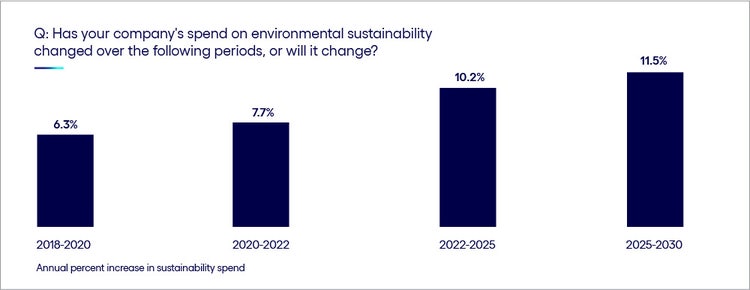
#
<p><span class="small">Source: Cognizant Research<br> Figure 1</span></p> <p>Convinced by the benefits of sustainability transformation, businesses across the Nordics have been given the green light to increase investment in their initiatives. The average annual growth in sustainability investment across Denmark, Finland, Norway and Sweden is expected to jump from 6.3% between 2018 and 2020, to 11.5% between 2025 and 2030.</p> <h4>#2: Elevate your internal sustainability initiatives for even greater returns</h4>
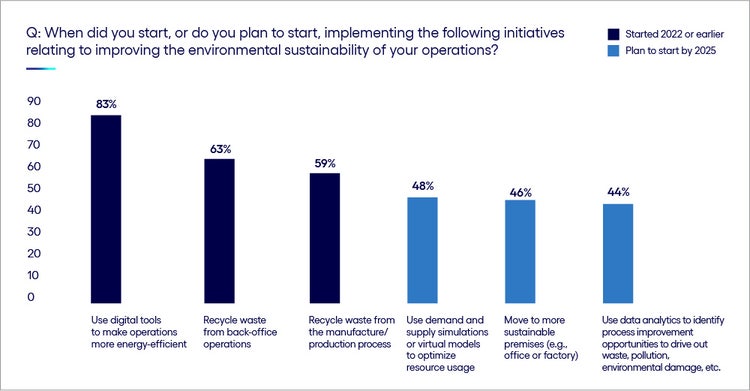
#
<p><span class="small">Source: Cognizant Research<br> Figure 2</span></p> <p>Businesses in the Nordics recognize that digital tools are fundamental to lowering their energy use, as more than eight in 10 are using them today to make their operations more energy efficient. Other popular initiatives today focus on recycling waste, both in the back office (63%) and manufacturing (59%) operations.</p> <p>Looking ahead to 2025, many have plans to make premises and processes more sustainable (46%). Over 40% will start using digital twins and data analytics to identify green process improvements, reflecting the acknowledged power of digital to meet sustainability goals.</p> <h4>#3: Expand your sphere of influence, upstream and downstream, to achieve greater business benefits and impact</h4>
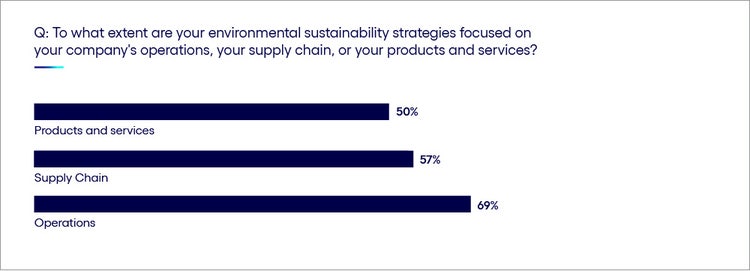
#
<p><span class="small">Source: Cognizant Research<br> Figure 3</span></p> <p>Over two-thirds (69%) of Nordics respondents said their organization’s sustainability strategy is greatly focused on operations, compared with 57% for supply chain and 50% for products and services. This emphasis on internal operations is completely justifiable as it stems from the confidence and control businesses can exert in this area.</p> <p>Conversely, it’s more difficult to effect change in areas traditionally out of their own control, such as the complexities of modern supply chains or the afterlife of a product once in the customer’s hands. Today’s technology, however, extends business reach, providing visibility and influence across the entire value chain when deployed effectively.</p> <h4>#4: Explore new ways to apply and deploy mature and emerging technology</h4>
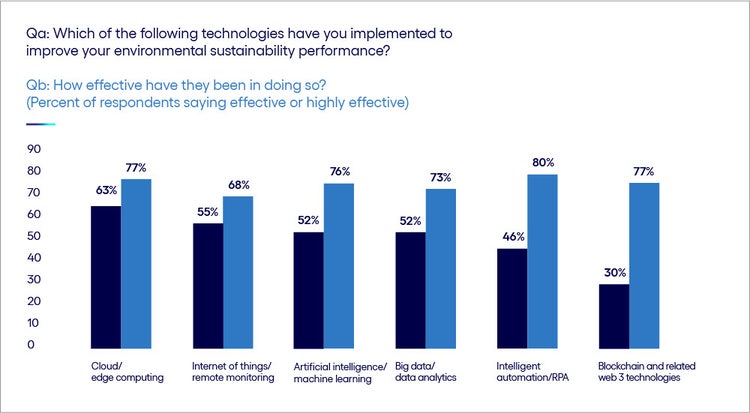
#
<p><span class="small">Source: Cognizant Research<br> Figure 4</span></p> <p>Cloud, IoT and AI are the most commonly implemented technologies to stimulate sustainability efforts. However, there are some less deployed technologies that may be even more effective. For example, although only 46% of businesses in the Nordics have applied intelligent automation, eight in 10 of those that have done it say it’s effective.</p> <h4>#5: Evolve power structures to allow for necessary shifts in culture and accountability</h4>
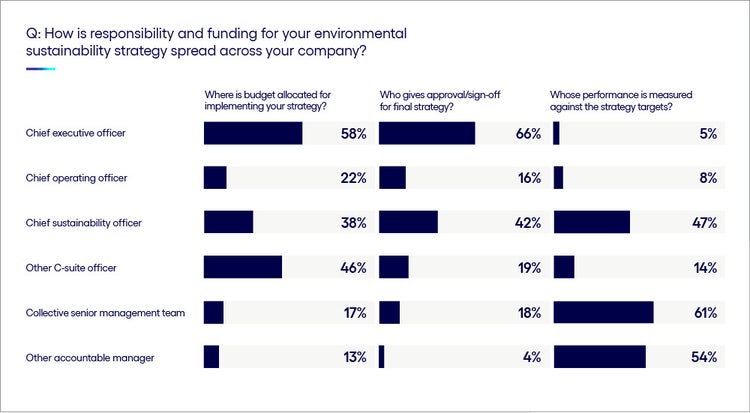
#
<p><span class="small">Source: Cognizant Research<br> Figure 5</span></p> <p>While it’s primarily CEOs in the Nordics who allocate the sustainability budget (58%) and approve the sustainability strategy (66%), very few (5%) are accountable or have their performance measured against the strategy’s success. Instead, it’s the chief sustainability officers and other managers who are responsible for outcomes, despite their absence from the strategy table.</p> <p>To embed sustainability into company culture, businesses must clarify roles and responsibilities, and clearly connect these to an incentives system to encourage senior leaders and all employees to participate in sustainability endeavors.</p> <p><i>Learn how your business (or you) can become sustainable to the core </i><a href="https://www.cognizant.com/us/en/insights/perspectives/sustainability-in-business-beyond-green-to-deeply-green-wf1518050" target="_blank"><i>in our report</i></a><i>, “Deep Green: How data, technology and collaboration will drive the next phase of sustainability in business.</i></p> <p><i>For even more on this topic, visit our </i><a href="https://www.cognizant.com/us/en/insights/sustainability-resilience" target="_blank"><i>Sustainability & Resilience webpage</i></a><i>.</i></p> <p><i>This article was written by Adam Karnama, Chief Sustainability Officer, Nordics, and Noah Nzuki, ESG Expert, Core Technologies & Insights, in Cognizant’s Artificial Intelligence & Analytics practice.</i></p>
<p>We’re here to offer you practical and unique solutions to today’s most pressing technology challenges. Across industries and markets, get inspired today for success tomorrow.</p>
